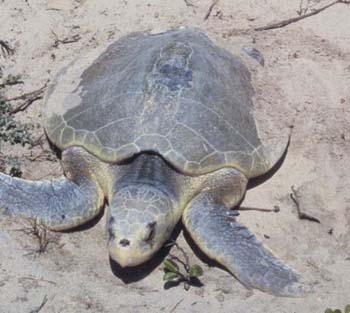
As best anyone can tell, sometime during the middle of May a female Kemp’s ridley turtle crawled out of the surf on South Padre Island and was struck by a passing vehicle. The cautionary tale illustrates why biologists are asking beachgoers to keep an eye out for the endangered sea turtles and report sightings.
Injured and confused, the turtle returned to the warm Gulf waters for nearly a week. Then, on May 23, the turtle came ashore again. After the animal successfully deposited her clutch of eggs in the sand, volunteers noticed her injuries and took her to Sea Turtle, Inc. There, a veterinarian noted the severe infection and estimated the turtle had only about a week to live. She was euthanized the following day.
The Kemp’s ridley turtle’s extraordinary drive to reproduce bodes well for the world’s smallest marine turtle species. Weighing-in at about 100 pounds as adults, the turtles once came ashore on Gulf of Mexico beaches — in northern Mexico mostly, but also in South Texas — in the tens of thousands in a phenomenon known as an arribada (arrival).
Then, the population collapsed, with the total number of observed nesting turtles as recently as two decades ago sinking to just several hundred individuals.
Today, the news for the ridley (it’s still listed as an endangered species) is mostly good-more of these turtles continue to nest on Texas beaches than in past years, including some who were reared in captivity and released years ago and are now returning to nest as adults.
As of May 28, 106 nests have been reported on Texas beaches, from Bolivar Peninsula on the upper coast to Boca Chica at the Rio Grande. May 17 set a one-day observation record of 19 nests.
“Unless this is a very early nesting year, it’s likely we will set another record for Kemp’s ridleys nesting on the Texas coast,” said Donna Shaver, Ph.D., chief of the sea turtle science and recovery program at Padre Island National Seashore. Some 128 nests were recorded last year, the largest number since monitoring began in 1980.
The recent run of sea turtle sightings signals the arrival of peak turtle nesting season in Texas that may last through mid-July.
For the past several years, Texas Parks and Wildlife Department has worked with a host of other agencies including the National Park Service, U.S. Fish and Wildlife Service, National Marine Fisheries Service, Gladys Porter Zoo, University of Texas, officials in Mexico and others to restore the Kemp’s ridley.
To protect as many sea turtles as possible, the Padre Island National Seashore incubates most of the sea turtle eggs found along the Texas coast and releases the hatchlings into the Gulf of Mexico.
Shaver urged beachgoers to be especially vigilant through mid-July, particularly on windy days when the turtles are most likely to come ashore.
“Reduce your speed while driving on the beach,” she said. “The turtles often cross the vehicular roadway on the beach, and might nest anywhere from the high tide line to the dunes. They will not and cannot move for an approaching vehicle and blend-in very well with the both sand and vegetation.”
Shaver encourages people who do sight a nesting sea turtle to mark the nest without disturbing the animal and to flag down a passing “turtle patrol.” If mobile phone reception is available, call 1-866-TURTLES, she said.
“Observations from the public are very important,” Shaver noted. “Up to about half the nests located on the Texas coast each year are due to reports from the public.”
The public also can witness sea turtle hatchling releases at the national seashore on certain dates mid-June through August. The releases usually take place around 6:45 a.m. and are free to attend-see the national seashore sea turtle Web pages for details. General information about Kemp’s ridley turtles also is available on the TPWD Web site.